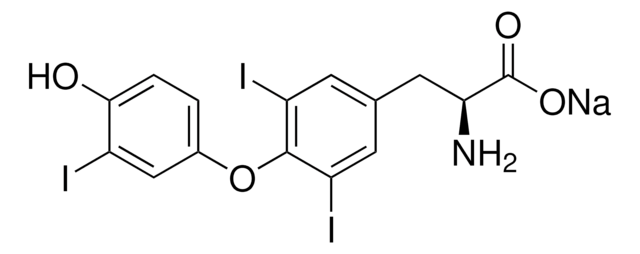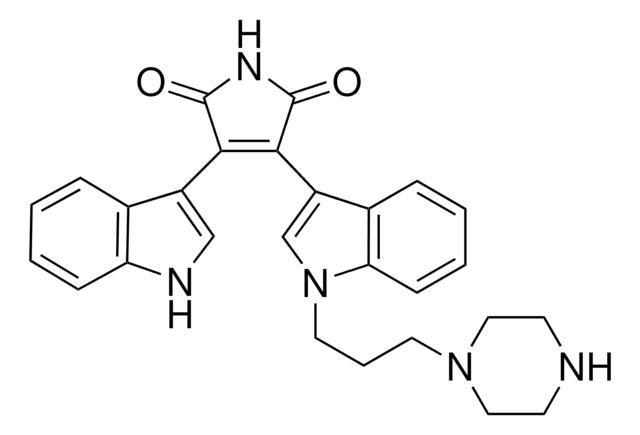추천 제품
생물학적 소스
mouse
Quality Level
결합
unconjugated
항체 형태
ascites fluid
항체 생산 유형
primary antibodies
클론
99D, monoclonal
분자량
antigen 65-75 kDa
포함
15 mM sodium azide
종 반응성
rabbit, mouse, rat, avian, human
기술
flow cytometry: suitable
immunocytochemistry: suitable using nucleoplasm, subnuclear punctate compartment, and cytoplasm
immunohistochemistry (frozen sections): suitable
immunoprecipitation (IP): suitable
indirect ELISA: suitable
western blot: 1:50,000 using a rat brain cytosol preparation
동형
IgG2b
UniProt 수납 번호
배송 상태
dry ice
저장 온도
−20°C
타겟 번역 후 변형
unmodified
유전자 정보
human ... BIN1(274)
mouse ... Bin1(30948)
rat ... Bin1(117028)
일반 설명
Monoclonal Anti-Bin1 (SH3P9, Amphiphysin II, amphl) (mouse IgG2b isotype) is derived from the 99D hybridoma produced by the fusion of mouse myeloma cells and splenocytes from BALB/c mice immunized with a recombinant polypeptide, containing amino acids 189-398 of human Bin1. Bin1 [Box-dependent myc-interacting protein-1, also known as SH3P9, amphiphysin II and amphl (amphiphysin-like)] is a novel protein that has features of a tumor suppressor. The human BIN1 gene has been mapped to chromosome 2q14. In human and rodent cells it appears as a short-lived (half-life of approx. 2 hrs) monomeric phosphoprotein (approx. 70 kDa). Bin1 molecule appears in different isoforms or conformations, and the localization varies between normal and tumor cells. In normal cells, Bin1 is predominantly nucleoplasmic, but is also present in a subnuclear compartment. In a panel of tumor cells that express Bin1, the predominant localization of the molecule is in the subnuclear compartment.
특이성
The antibody reacts specifically with a 33-residue segment of the myc-binding domain (MBD, amino acids 323-356) of the human Bin1 molecule. It does not react with the Bin1-related 45 kDa polypeptide.
면역원
recombinant polypeptide containing amino acids 189-398 of human Bin1.
애플리케이션
Monoclonal Anti-Bin1 antibody produced in mouse has been used in:
- western blotting
- enzyme linked immunosorbent assay (ELISA)
- immunoprecipitation
- immunocytochemistry
- immunohistochemistry
- flow cytometry
생화학적/생리학적 작용
Box-dependent myc-interacting protein-1 (Bin1) interacts with and inhibits the oncogenic activity of the myc oncoprotein that has a major role in many human cancers. The loss of Bin1 may contribute to growth deregulation in cancer cells in carcinoma of the breast, colon, lung, cervix, prostate and liver. In bin1 locus mid-2q region that is deleted in approx. 42% of metastatic prostate cancers, and at the syntenic murine locus, in >90% of radiation-induced myeloid leukemias. In addition to the role of Bin1 in controlling neoplastic cell growth and cell cycle by the inhibition of transformation by both myc and the adenovirus E1A protein. Deficits in expression are functionally significant, because ectopic Bin1 can inhibit the growth of tumor cells that lack endogenous expression. Bin1 has also been found to be highly expressed in murine skeletal muscle; overexpression of Bin1 promotes myotube formation and upregulation of myosin heavy chain, while interference with Bin1 expression significantly impairs these processes.
면책조항
Unless otherwise stated in our catalog or other company documentation accompanying the product(s), our products are intended for research use only and are not to be used for any other purpose, which includes but is not limited to, unauthorized commercial uses, in vitro diagnostic uses, ex vivo or in vivo therapeutic uses or any type of consumption or application to humans or animals.
적합한 제품을 찾을 수 없으신가요?
당사의 제품 선택기 도구.을(를) 시도해 보세요.
Storage Class Code
10 - Combustible liquids
WGK
WGK 3
Flash Point (°F)
Not applicable
Flash Point (°C)
Not applicable
Accumulation of caveolin-3 protein is limited in damaged muscle in chicken muscular dystrophy
Matsumoto H, et al.
Comparative Biochemistry and Physiology. Part A, Molecular & Integrative Physiology, 157(1), 68-72 (2010)
Endocytic proteins in the regulation of nuclear signaling, transcription and tumorigenesis
Pyrzynska B, et al.
Molecular Oncology, 3(4), 321-338 (2009)
Loss of heterozygosity and tumor suppressor activity of Bin1 in prostate carcinoma
Ge K, et al.
International Journal of Cancer. Journal International Du Cancer, 86(2), 155-161 (2000)
Bin1 SRC homology 3 domain acts as a scaffold for myofiber sarcomere assembly
Fernando P, et al.
The Journal of Biological Chemistry, 284(40), 27674-27686 (2009)
Characterization of bridging integrator 1 (BIN1) as a potential tumor suppressor and prognostic marker in hepatocellular carcinoma
Pan K, et al.
Molecular Medicine, 18(3), 507-518 (2012)
자사의 과학자팀은 생명 과학, 재료 과학, 화학 합성, 크로마토그래피, 분석 및 기타 많은 영역을 포함한 모든 과학 분야에 경험이 있습니다..
고객지원팀으로 연락바랍니다.

![[Leu15]-Gastrin I human ≥95% (HPLC)](/deepweb/assets/sigmaaldrich/product/structures/153/342/d4cb3dd7-13f1-46cf-8d1f-3907a5de7a83/640/d4cb3dd7-13f1-46cf-8d1f-3907a5de7a83.png)






